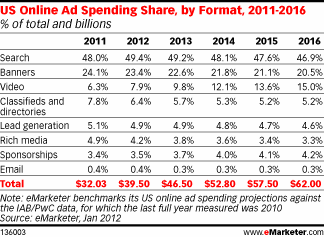 It is no secret that advertising over the internet is growing strongly with every year that goes by and predicted to continue doing so in the next few years. However, it is less clear how the online ad spending is divided by its own formats.
It is no secret that advertising over the internet is growing strongly with every year that goes by and predicted to continue doing so in the next few years. However, it is less clear how the online ad spending is divided by its own formats.
Understanding where most of the advertising funds of online business owners and marketers are going (and where predicted to) can assist us identify the general flow directions the web is heading towards, for better allocation of our own marketing efforts.
Search Is The King, Video Is The Fastest Growing
eMarketer has posted a thorough report of the U.S. online ad spend distribution among the different formats for 2011 and forecast changes until 2016 on a year by year basis. In general, the overall online ad spend will almost double itself, from $32 billion in 2011 to $62 billion in 2016.
When examining the online ad spend by format, we can see that almost all formats are predicted to grow, while the fastest growing ad format is clearly video. While in 2011 its share was 6.3%, by 2016 it will rise to 15%, surpassing classifieds and directories that will drop to 5.2% in 2016 from 7.8% in 2011.
However, with all due respect to online video advertising, search will remain the king of online advertising until 2016 where it will hold 46.9% share (compared to 48% in 2011). Banners, that will demonstrate healthy yearly growth rates, will drop to 20.5% share in 2016 from 24.1% in 2011.

The whole online advertising industry is changing mostly due to change of consuming behavior that leaning towards mobile. According to this theory, let’s analyze a little deeper the leading three online ad formats (search, banners and video) and see which companies benefits the most from it.
Search – Google and Bing
Last week i discussed about how the paid search industry will grow in the next three years, where it will mainly be driven from the growth of two search engines only (nearly 90% of the paid search combined). Google is by far the most dominant with nearly 80% of the share by 2014, while Bing will hold 8.7%.
When examining the mobile search market share it probably explains these trends- Google is controlling more than 90% of the mobile search market worldwide (!) where Yahoo (Bing’s search partner) has 6% and Bing has additional humble 1%.
Banners – Facebook?
The situation in the banners format is a bit more complex. While Facebook is currently the leading display ads (banners) on the web with 28%, it still hasn’t found a mobile ads product to monetize its 425 million mobile users (as revealed in its IPO filing).
In fact, Facebook raised its concerns about the increasing usage of mobile users while it yet to have any proved-working mobile monetization method. Although i am pretty certain that soon Facebook will roll out some mobile ads product, until it will prove it is effective enough, Facebook’s future dominance over the online display ads (banners) is in doubt.
Video – YouTube (!)
This is probably the easiest format to predict which company will benefit the most. YouTube rules the online video industry completely without any real competition and it doesn’t seem it will have one in the foreseen future.
The rise of smart mobile devices usage and as online video viewing from smartphones/tablets considered one of the most popular mobile activities, Google’s revenue from YouTube looks promising at the years to come.